⚔️⚔️
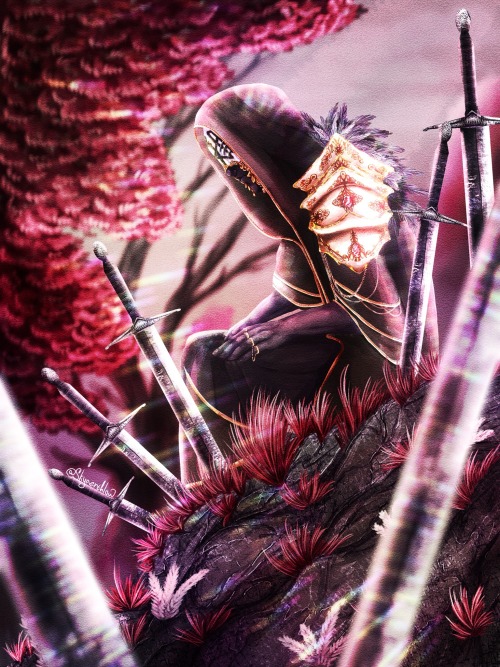
⚔️⚔️
↓
_______________________________________
[NOT FOR SALE] * →
* → This artwork was made not for the commercial purposes or gaining any profit
_______________________________________


More Posts from Twodollarcherricola and Others
"sadistic freak" and "pervert" very easily two of the best traits a character with healing powers can exhibit
Words for Skin Tone | How to Describe Skin Color
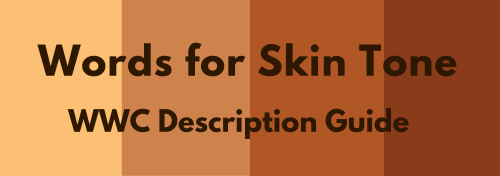
We discussed the issues describing People of Color by means of food in Part I of this guide, which brought rise to even more questions, mostly along the lines of “So, if food’s not an option, what can I use?” Well, I was just getting to that!
This final portion focuses on describing skin tone, with photo and passage examples provided throughout. I hope to cover everything from the use of straight-forward description to the more creatively-inclined, keeping in mind the questions we’ve received on this topic.
Standard Description
Basic Colors

Pictured above: Black, Brown, Beige, White, Pink.
“She had brown skin.”
This is a perfectly fine description that, while not providing the most detail, works well and will never become cliché.
Describing characters’ skin as simply brown or beige works on its own, though it’s not particularly telling just from the range in brown alone.
Complex Colors
These are more rarely used words that actually “mean” their color. Some of these have multiple meanings, so you’ll want to look into those to determine what other associations a word might have.

Pictured above: Umber, Sepia, Ochre, Russet, Terra-cotta, Gold, Tawny, Taupe, Khaki, Fawn.
Complex colors work well alone, though often pair well with a basic color in regards to narrowing down shade/tone.
For example: Golden brown, russet brown, tawny beige…
As some of these are on the “rare” side, sliding in a definition of the word within the sentence itself may help readers who are unfamiliar with the term visualize the color without seeking a dictionary.
“He was tall and slim, his skin a russet, reddish-brown.”
Comparisons to familiar colors or visuals are also helpful:
“His skin was an ochre color, much like the mellow-brown light that bathed the forest.”
Modifiers
Modifiers, often adjectives, make partial changes to a word.The following words are descriptors in reference to skin tone.
Dark - Deep - Rich - Cool
Warm - Medium - Tan
Fair - Light - Pale
Rich Black, Dark brown, Warm beige, Pale pink…
If you’re looking to get more specific than “brown,” modifiers narrow down shade further.
Keep in mind that these modifiers are not exactly colors.
As an already brown-skinned person, I get tan from a lot of sun and resultingly become a darker, deeper brown. I turn a pale, more yellow-brown in the winter.
While best used in combination with a color, I suppose words like “tan” “fair” and “light” do work alone; just note that tan is less likely to be taken for “naturally tan” and much more likely a tanned White person.
Calling someone “dark” as description on its own is offensive to some and also ambiguous. (See: Describing Skin as Dark)
Undertones
Undertones are the colors beneath the skin, seeing as skin isn’t just one even color but has more subdued tones within the dominating palette.
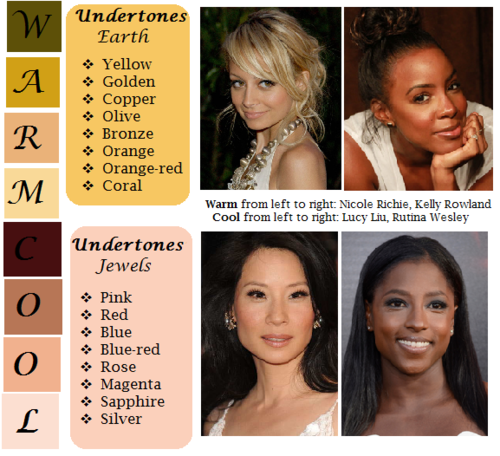
pictured above: warm / earth undertones: yellow, golden, copper, olive, bronze, orange, orange-red, coral | cool / jewel undertones: pink, red, blue, blue-red, rose, magenta, sapphire, silver.
Mentioning the undertones within a character’s skin is an even more precise way to denote skin tone.
As shown, there’s a difference between say, brown skin with warm orange-red undertones (Kelly Rowland) and brown skin with cool, jewel undertones (Rutina Wesley).
“A dazzling smile revealed the bronze glow at her cheeks.”
“He always looked as if he’d ran a mile, a constant tinge of pink under his tawny skin.”
Standard Description Passage
“Farah’s skin, always fawn, had burned and freckled under the summer’s sun. Even at the cusp of autumn, an uneven tan clung to her skin like burrs. So unlike the smooth, red-brown ochre of her mother, which the sun had richened to a blessing.”
-From my story “Where Summer Ends” featured in Strange Little Girls
Here the state of skin also gives insight on character.
Note my use of “fawn” in regards to multiple meaning and association. While fawn is a color, it’s also a small, timid deer, which describes this very traumatized character of mine perfectly.
Though I use standard descriptions of skin tone more in my writing, at the same time I’m no stranger to creative descriptions, and do enjoy the occasional artsy detail of a character.
Creative Description
Whether compared to night-cast rivers or day’s first light…I actually enjoy seeing Characters of Colors dressed in artful detail.
I’ve read loads of descriptions in my day of white characters and their “smooth rose-tinged ivory skin”, while the PoC, if there, are reduced to something from a candy bowl or a Starbucks drink, so to actually read of PoC described in lavish detail can be somewhat of a treat.
Still, be mindful when you get creative with your character descriptions. Too many frills can become purple-prose-like, so do what feels right for your writing when and where. Not every character or scene warrants a creative description, either. Especially if they’re not even a secondary character.
Using a combination of color descriptions from standard to creative is probably a better method than straight creative. But again, do what’s good for your tale.
Natural Settings - Sky

Pictured above: Harvest Moon -Twilight, Fall/Autumn Leaves, Clay, Desert/Sahara, Sunlight - Sunrise - Sunset - Afterglow - Dawn- Day- Daybreak, Field - Prairie - Wheat, Mountain/Cliff, Beach/Sand/Straw/Hay.
Now before you run off to compare your heroine’s skin to the harvest moon or a cliff side, think about the associations to your words.
When I think cliff, I think of jagged, perilous, rough. I hear sand and picture grainy, yet smooth. Calm. mellow.
So consider your character and what you see fit to compare them to.
Also consider whose perspective you’re describing them from. Someone describing a person they revere or admire may have a more pleasant, loftier description than someone who can’t stand the person.
“Her face was like the fire-gold glow of dawn, lifting my gaze, drawing me in.”
“She had a sandy complexion, smooth and tawny.”
Even creative descriptions tend to draw help from your standard words.
Flowers
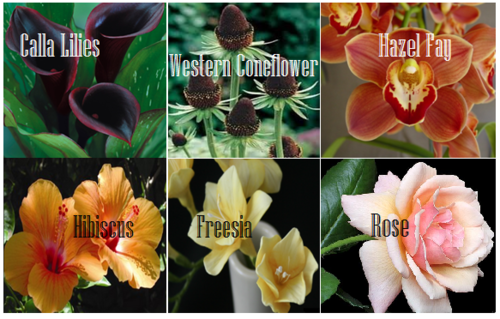
Pictured above: Calla lilies, Western Coneflower, Hazel Fay, Hibiscus, Freesia, Rose
It was a bit difficult to find flowers to my liking that didn’t have a 20 character name or wasn’t called something like “chocolate silk” so these are the finalists.
You’ll definitely want to avoid purple-prose here.
Also be aware of flowers that most might’ve never heard of. Roses are easy, as most know the look and coloring(s) of this plant. But Western coneflowers? Calla lilies? Maybe not so much.
“He entered the cottage in a huff, cheeks a blushing brown like the flowers Nana planted right under my window. Hazel Fay she called them, was it?”
Assorted Plants & Nature

Pictured above: Cattails, Seashell, Driftwood, Pinecone, Acorn, Amber
These ones are kinda odd. Perhaps because I’ve never seen these in comparison to skin tone, With the exception of amber.
At least they’re common enough that most may have an idea what you’re talking about at the mention of “pinecone."
I suggest reading out your sentences aloud to get a better feel of how it’ll sounds.
"Auburn hair swept past pointed ears, set around a face like an acorn both in shape and shade.”
I pictured some tree-dwelling being or person from a fantasy world in this example, which makes the comparison more appropriate.
I don’t suggest using a comparison just “cuz you can” but actually being thoughtful about what you’re comparing your character to and how it applies to your character and/or setting.
Wood

Pictured above: Mahogany, Walnut, Chestnut, Golden Oak, Ash
Wood can be an iffy description for skin tone. Not only due to several of them having “foody” terminology within their names, but again, associations.
Some people would prefer not to compare/be compared to wood at all, so get opinions, try it aloud, and make sure it’s appropriate to the character if you do use it.
“The old warlock’s skin was a deep shade of mahogany, his stare serious and firm as it held mine.”
Metals

Pictured above: Platinum, Copper, Brass, Gold, Bronze
Copper skin, brass-colored skin, golden skin…
I’ve even heard variations of these used before by comparison to an object of the same properties/coloring, such as penny for copper.
These also work well with modifiers.
“The dress of fine white silks popped against the deep bronze of her skin.”
Gemstones - Minerals
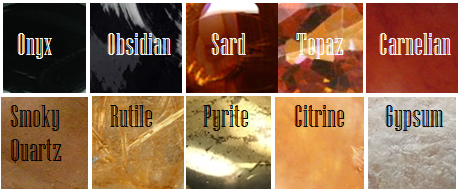
Pictured above: Onyx, Obsidian, Sard, Topaz, Carnelian, Smoky Quartz, Rutile, Pyrite, Citrine, Gypsum
These are trickier to use. As with some complex colors, the writer will have to get us to understand what most of these look like.
If you use these, or any more rare description, consider if it actually “fits” the book or scene.
Even if you’re able to get us to picture what “rutile” looks like, why are you using this description as opposed to something else? Have that answer for yourself.
“His skin reminded her of the topaz ring her father wore at his finger, a gleaming stone of brown, mellow facades.”
Physical Description
Physical character description can be more than skin tone.
Show us hair, eyes, noses, mouth, hands…body posture, body shape, skin texture… though not necessarily all of those nor at once.
Describing features also helps indicate race, especially if your character has some traits common within the race they are, such as afro hair to a Black character.
How comprehensive you decide to get is up to you. I wouldn’t overdo it and get specific to every mole and birthmark. Noting defining characteristics is good, though, like slightly spaced front teeth, curls that stay flopping in their face, hands freckled with sunspots…
General Tips
Indicate Race Early: I suggest indicators of race be made at the earliest convenience within the writing, with more hints threaded throughout here and there.
Get Creative On Your Own: Obviously, I couldn’t cover every proper color or comparison in which has been “approved” to use for your characters’ skin color, so it’s up to you to use discretion when seeking other ways and shades to describe skin tone.
Skin Color May Not Be Enough: Describing skin tone isn’t always enough to indicate someone’s ethnicity. As timeless cases with readers equating brown to “dark white” or something, more indicators of race may be needed.
Describe White characters and PoC Alike: You should describe the race and/or skin tone of your white characters just as you do your Characters of Color. If you don’t, you risk implying that White is the default human being and PoC are the “Other”).
PSA: Don’t use “Colored.” Based on some asks we’ve received using this word, I’d like to say that unless you or your character is a racist grandmama from the 1960s, do not call People of Color “colored” please.
Not Sure Where to Start? You really can’t go wrong using basic colors for your skin descriptions. It’s actually what many people prefer and works best for most writing. Personally, I tend to describe my characters using a combo of basic colors + modifiers, with mentions of undertones at times. I do like to veer into more creative descriptions on occasion.
Want some alternatives to “skin” or “skin color”? Try: Appearance, blend, blush, cast, coloring, complexion, flush, glow, hue, overtone, palette, pigmentation, rinse, shade, sheen, spectrum, tinge, tint, tone, undertone, value, wash.
Skin Tone Resources
List of Color Names
The Color Thesaurus
Skin Undertone & Color Matching
Tips and Words on Describing Skin
Photos: Undertones Described (Modifiers included)
Online Thesaurus (try colors, such as “red” & “brown”)
Don’t Call me Pastries: Creative Skin Tones w/ pics I
Writing & Description Guides
WWC Featured Description Posts
WWC Guide: Words to Describe Hair
Writing with Color: Description & Skin Color Tags
7 Offensive Mistakes Well-intentioned Writers Make
I tried to be as comprehensive as possible with this guide, but if you have a question regarding describing skin color that hasn’t been answered within part I or II of this guide, or have more questions after reading this post, feel free to ask!
~ Mod Colette
I'll say I'm not super into any fandom at the moment and then remember that I not only applied to two colleges partially because of All For the Game but I will be visiting one of the schools the day after the new book comes out
It’s so important to me that the Foxes annoy Kevin.
Like the poor boy had no friends on his team and throughout his childhood. The only people he loved and cared about after his mom were
Jean, who he had to watch be and beaten and tortured and abused until the fight went out of him and then until he tried to kill himself and then be tortured again for failing to die and at least Kevin was a pet, Jean just a toy to be broken and taken away and used and discarded.
And Riko who abused him and manipulated him and took pleasure in beating him down while acting like they were closer than friends, actual brothers.
The Master who is so horrible that Kevin barely even speaks of him.
And then he’s treated as this godlike son of Exy by the public. Aside from Jeremy, it seems like the other teams aren’t even immune. He’s not a college athlete, he’s this unfathomable celebrity.
And then the Foxes are just SO unimpressed and actively annoyed with him. They bicker and tease but there’s no bite. Not like the Ravens. They drag him along on their fun excursions at knife point because it’s important that he’s there with them. They force him to have fun and ride horses and hike in the mountains while also respecting his skills on the court. They stock their home with cheese and candy bars and make him eat ice cream at crap diners and go dancing in clubs. And not all of it is healthy, Kevin’s self medicating with vodka for sure, and the behavior of the monsters is dubious at best especially in the first book, but they bring him along because they want him there. Not Kevin Day: Rising star of Exy. They want Kevin Day: Mega Nerd.
The Ravens hurt and tore each other apart in any way they could, nothing but venom and malice behind their words. Nicky calls him a brat and the in the affectionate ton calls him family. Kevin and Jean’s sexualities were used against them, another item for Riko’s amusement, the Ravens have hate sex more than actual care. Allison is visibly disgusted at the thought of hooking up and no one pushes it beyond characteristic teasing
Andrew is chronically annoyed with Kevin but follows him everywhere like a goalkeeper shaped safety blanket because years of the Nest leave Kevin anxious when alone. He’s capable of the same violence as the other Ravens but he never actually hurts Kevin until the last book. He gives Kevin his pills and his game and his house and his family and his trust but not his respect. Not always. It’s the same brutal healing he gave Matt.
Allison calls his tattoo, a number forced on him since childhood, a tramp stamp. Riko would kill him for removing it but the Foxes basically riot with happiness when he changes it.
Kevin was locked in the Nest, monitored at every move, watched and betrayed and even when he was able to leave, was shackled to Riko and Ichirou and forced to lie and perform while hurting. Wymack gives him keys to the court, to his home. Abby opens up her home for him to stay at over the holidays. Andrew and Aaron and Nicky bring him into their home and their favorite restaurant and club.
Do you think Kevin’s ever afraid of turning into Riko or Ichirou? We know Jean struggles with Raven impulses, especially when teaching. Do you think Kevin ever looked at tiny, fierce, stupid, stubborn Neil Josten and was afraid he’d hurt him on instinct? Do you think he was crushed by the honor of knowing that, in Nathaniel’s last days alive, he still wanted Kevin to train him?
No one could ever speak out against Riko, Kevin could never truly be himself. Everyone speaks out against Riko, Neil actively sasses the press.
Everyone teases Kevin and rolls their eyes and pushes his buttons while holding him close
And then, the one time true violence is turned against him by a teammate it’s in defense of Neil and immediately three other teammates intervene. They all platonically share a room because they’re so worried about Neil when he comes back. They’re angry and upset with Kevin but Andrew threatens him at knife point to go on vacation with them. They hear about the ugly truth of Kevin’s life and again and again and band around him every time. They treat him like a person, like a teammate, like family.
It’s important to me that they, like the fandom, think Kevin is a little bit of a diva and that they tell him that to his face. That they think he’s a nerd but let him ramble.
They call Neil his “mini me” and they all love Neil so much. I hope Kevin sees how they treat Neil who’s equally obsessive, equally intense, equally traumatized, equally as tied to gangsters and realizes that they love him too. That the insults and teasing are a love language
Idk man, just Kevin being treated like a person. This big burning star getting vetoed on a candy drawer and receiving his teammate's playful horror to his media personality because that is NOT our boy and being accepted for exactly who he is: a person who’s allowed to be imperfect and dramatic and safe to tease about it.
I think some of the things in AFTG don't make sense to a lot of people who aren't also abuse victims, and it means that a lot of fandom posts are just... wrong?
Like, I really don’t think Jeremy going to the press about his family's abuse would help him. He's financially dependent on them; his ability to go to USC and not be in prison hinge on his family's support. They're classic abusers in that they've tied him down.
Just like Andrew couldn't just tell his foster parents about the abuse; the ones who knew didn't care anyway.
There's a perfect example of this in Kevin leaving the Nest and making things worse on Jean. Riko's rage towards Kevin was just turned onto Jean. The abuse didn't end; it was just redirected. And Kevin was still traumatized and constantly in danger. He couldn't go anywhere near the Nest safely. He couldn't talk about what happened publicly without facing retaliation.
All of this is true for Jeremy, too. Financial and emotional abuse is still dangerous; he can't just suddenly leave. He can't just stay at Laila's place and try to hide; that kind of reset is both horrifying and extremely dangerous for most victims.
I feel like people who aren't victims just miss half the context of AFTG. I wouldn't wish that depth of understanding on anyone because this series hurts me intensely. But I do wish I could explain it to people better.
Anyway normalize stutters, stilted speech, flat affect, monotone speech, volume control issues, nonverbal communication devices, voice modulators, speech impediments, lisps, oral deformities.
Normalize "abnormal" speech patterns. Normalize lack of eye contact, normalize ticking, normalize emphasis on different syllables. Normalize "Inappropriate" emoting, especially when it's a stress response.
Normalize verbally processing thoughts, external system communication, non- aggressive interaction with hallucinations or delusions.
Normalize Echolalia, "TV Talking", vocal stimming, parroting, "Baby talk" as a way to self soothe.
soda hong lu pride flag

pride shrimps
-
 sikoi liked this · 1 month ago
sikoi liked this · 1 month ago -
 myhomeisamongthetrees liked this · 1 month ago
myhomeisamongthetrees liked this · 1 month ago -
 shanwan liked this · 1 month ago
shanwan liked this · 1 month ago -
 hat-man-with-crab-rangoon liked this · 1 month ago
hat-man-with-crab-rangoon liked this · 1 month ago -
 virberos reblogged this · 1 month ago
virberos reblogged this · 1 month ago -
 nanalis120 liked this · 1 month ago
nanalis120 liked this · 1 month ago -
 zelsius liked this · 1 month ago
zelsius liked this · 1 month ago -
 ivyluvr19 liked this · 1 month ago
ivyluvr19 liked this · 1 month ago -
 imageocd reblogged this · 1 month ago
imageocd reblogged this · 1 month ago -
 imageocd liked this · 1 month ago
imageocd liked this · 1 month ago -
 sapphysthingss liked this · 1 month ago
sapphysthingss liked this · 1 month ago -
 noheadcanons-juststories liked this · 1 month ago
noheadcanons-juststories liked this · 1 month ago -
 shonwebber-blog liked this · 1 month ago
shonwebber-blog liked this · 1 month ago -
 pepto-the-abysmal liked this · 1 month ago
pepto-the-abysmal liked this · 1 month ago -
 signalterminated reblogged this · 1 month ago
signalterminated reblogged this · 1 month ago -
 auroraoakland liked this · 1 month ago
auroraoakland liked this · 1 month ago -
 weegeeweegee reblogged this · 1 month ago
weegeeweegee reblogged this · 1 month ago -
 weegeeweegee liked this · 1 month ago
weegeeweegee liked this · 1 month ago -
 autumnstar06 liked this · 1 month ago
autumnstar06 liked this · 1 month ago -
 pearbearr liked this · 1 month ago
pearbearr liked this · 1 month ago -
 nnssssstuff liked this · 1 month ago
nnssssstuff liked this · 1 month ago -
 artisticethan liked this · 1 month ago
artisticethan liked this · 1 month ago -
 newto-onn liked this · 1 month ago
newto-onn liked this · 1 month ago -
 t-lomeres reblogged this · 1 month ago
t-lomeres reblogged this · 1 month ago -
 t-lomeres liked this · 1 month ago
t-lomeres liked this · 1 month ago -
 crittersweets liked this · 1 month ago
crittersweets liked this · 1 month ago -
 comatosearts liked this · 1 month ago
comatosearts liked this · 1 month ago -
 inconvenient-ideal liked this · 1 month ago
inconvenient-ideal liked this · 1 month ago -
 stars-of-shadowmoon liked this · 1 month ago
stars-of-shadowmoon liked this · 1 month ago -
 deadly-gay-frog liked this · 2 months ago
deadly-gay-frog liked this · 2 months ago -
 yalubluspat liked this · 2 months ago
yalubluspat liked this · 2 months ago -
 bluehairpunklol reblogged this · 2 months ago
bluehairpunklol reblogged this · 2 months ago -
 bluehairpunklol liked this · 2 months ago
bluehairpunklol liked this · 2 months ago -
 b1gr4tm4n liked this · 2 months ago
b1gr4tm4n liked this · 2 months ago -
 whimzak liked this · 2 months ago
whimzak liked this · 2 months ago -
 anaphorathe liked this · 2 months ago
anaphorathe liked this · 2 months ago -
 alterego102389 liked this · 2 months ago
alterego102389 liked this · 2 months ago -
 xces-high liked this · 2 months ago
xces-high liked this · 2 months ago -
 several-mentally-ill-rats liked this · 2 months ago
several-mentally-ill-rats liked this · 2 months ago -
 yfcnz123money liked this · 2 months ago
yfcnz123money liked this · 2 months ago -
 eminemsboyfriend liked this · 2 months ago
eminemsboyfriend liked this · 2 months ago -
 whateveriwant reblogged this · 2 months ago
whateveriwant reblogged this · 2 months ago -
 w0manof-flesh44 liked this · 2 months ago
w0manof-flesh44 liked this · 2 months ago -
 hellkitten813 liked this · 2 months ago
hellkitten813 liked this · 2 months ago -
 friendsareweird liked this · 2 months ago
friendsareweird liked this · 2 months ago -
 sin-sick-soul liked this · 2 months ago
sin-sick-soul liked this · 2 months ago -
 aeshiteiru reblogged this · 2 months ago
aeshiteiru reblogged this · 2 months ago -
 wife-of-the-wonderduo liked this · 2 months ago
wife-of-the-wonderduo liked this · 2 months ago -
 httpshayley liked this · 2 months ago
httpshayley liked this · 2 months ago

he/him | 18+ (another) autistic compsci major artist / writer sometimes. ttrpg enjoyer. musician who can't write songs.
104 posts







